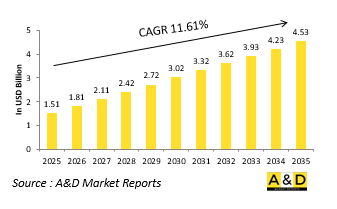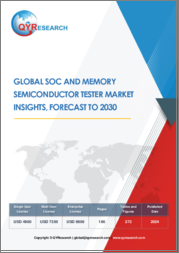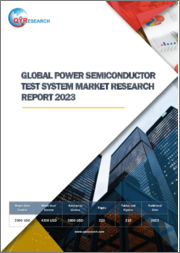
|
시장보고서
상품코드
1715443
세계의 반도체 테스트 시스템 시장(2025-2035년)Global Semiconductor Test System Market 2025-2035 |
||||||
세계 반도체 테스트 시스템 시장 규모는 2025년에 15억 1,000만 달러, 2035년에는 45억 3,000만 달러에 달할 것으로 예상되며, 예측 기간인 2025-2035년 11.61%의 연평균 복합 성장률(CAGR)을 보일 것으로 예측됩니다.

반도체 테스트 시스템 시장 소개
군용 반도체 테스트 시스템은 국방 플랫폼에 사용되는 마이크로 전자 부품의 성능, 내구성 및 보안을 검증하는 데 필수적인 도구입니다. 이 시스템은 마이크로프로세서, 메모리 칩, 파워 반도체, 신호 프로세서와 같은 반도체 장비가 군용 용도의 엄격한 신뢰성 및 환경 요건을 충족하는지 확인하기 위해 특별히 설계되었습니다. 현대의 국방 시스템이 고성능 컴퓨팅, 첨단 감지 및 실시간 데이터 처리에 대한 의존도가 높아짐에 따라 반도체의 역할이 크게 확대되고 있습니다. 유도탄과 레이더 시스템에서 항공 전자공학 및 우주 기반 감시까지 모든 것의 중심에 반도체가 있으며, 엄격한 테스트가 필수적입니다. 군용 반도체 테스트 시스템은 전기적 특성과 기능적 거동을 검증할 뿐만 아니라 극한의 온도, 방사선 노출, 전자기 간섭에 대한 부품의 반응도 평가합니다. 사이버 물리 위협과 반도체 공급망의 취약성이 증가하는 시대에 안전하고 종합적인 테스트 시스템은 미션 크리티컬한 전자제품의 신뢰성과 복원력을 입증하는 데 필수적입니다. 전 세계적으로 집적회로의 복잡성 증가와 SoC 설계로의 전환은 군사 R&D, 생산 및 유지보수 생태계 전반에 걸쳐 확장 가능하고 안전한 고급 테스트 솔루션의 필요성을 높이고 있습니다.
반도체 테스트 시스템 시장에서 기술의 영향
기술의 발전으로 인해 군용 반도체 테스트 시스템의 역량이 더욱 빨라지고, 정확도가 높아지고, 복잡한 디바이스 아키텍처에 대한 적응성이 강화되면서 군용 반도체 테스트 시스템의 역량이 재정의되고 있습니다. 머신러닝 알고리즘의 통합은 테스트 주기 동안 고장 식별 및 패턴 인식의 속도를 높여 진단을 간소화하고 처리량을 향상시킬 수 있습니다. 방위용 일렉트로닉스이 이기종 통합 및 3D 패키징으로 진화함에 따라, 테스트 시스템은 이제 신호 왜곡을 최소화하고 최고의 정확도로 멀티 다이 및 고밀도 칩 구성을 지원해야 합니다. 열/방사선 시뮬레이션의 혁신으로 칩의 무결성을 손상시키지 않고 우주 및 핵 환경용 반도체를 테스트할 수 있게 되었습니다. 고속 자동 테스트 장비(ATE) 플랫폼은 모듈화 및 소프트웨어 정의가 더욱 발전하여 사용자가 장비 유형 및 작전 프로파일에 따라 테스트 시나리오를 동적으로 재구성할 수 있게 되었습니다. 또한, 실시간 분석 및 데이터 시각화 도구는 검증 프로세스에서 의사결정을 개선하고 엔지니어가 이상을 조기에 발견할 수 있도록 돕고 있습니다. 사이버 어슈어런스와 하드웨어 검증의 융합이 진행되면서 임베디드 보안 기능을 검증하고 하드웨어 수준의 변조를 감지할 수 있는 안전한 테스트 환경도 개발되고 있습니다. 이러한 기술을 통해 반도체 테스트는 군사 시스템의 운영 우위와 전자적 신뢰성을 확보하기 위한 중요한 축으로 자리매김하고 있습니다.
반도체 테스트 시스템 시장의 주요 촉진요인
국방 시스템의 복잡성과 반도체 신뢰성의 전략적 중요성은 군용 반도체 테스트 시스템에 대한 수요 증가를 촉진하는 주요 요인입니다. 전 세계 군가 자율 플랫폼, AI 지원 의사결정 시스템, 광대역 통신 네트워크로 전환함에 따라 이러한 시스템에 포함된 반도체 함량이 급증하고 있습니다. 이러한 칩은 각각 높은 스트레스와 위협이 높은 환경에서 완벽하게 작동할 수 있도록 철저한 테스트를 거쳐야 합니다. 위조 부품 및 사이버 침입에 대한 우려는 특히 민감한 방위산업 공급망에서 신뢰할 수 있는 반도체 검증에 대한 요구를 더욱 강화하고 있습니다.
세계의 반도체 테스트 시스템 시장에 대해 조사 분석했으며, 성장 촉진요인, 향후 10년간의 전망, 지역별 동향 등의 정보를 전해드립니다.
목차
세계의 반도체 테스트 시스템 시장 보고서 정의
세계의 반도체 테스트 시스템 시장 세분화
지역별
유형별
용도별
기술별
향후 10년간 세계의 반도체 테스트 시스템 시장 분석
세계의 반도체 테스트 시스템 시장 기술
세계의 반도체 테스트 시스템 시장 예측
지역별 반도체 테스트 시스템 시장 동향과 예측
북미
성장 촉진요인, 억제요인, 과제
PEST
시장 예측과 시나리오 분석
주요 기업
공급업체 Tier 상황
기업 벤치마킹
유럽
중동
아시아태평양
남미
액세스 컨트롤 시장 국가별 분석
미국
방위 프로그램
최신 뉴스
특허
시장 예측과 시나리오 분석
캐나다
이탈리아
프랑스
독일
네덜란드
벨기에
스페인
스웨덴
그리스
호주
남아프리카공화국
인도
중국
러시아
한국
일본
말레이시아
싱가포르
브라질
세계의 반도체 테스트 시스템 시장 기회 매트릭스
세계의 반도체 테스트 시스템 시장 보고서에 관한 전문가 의견
결론
Aviation and Defense Market Reports에 대해
LSH 25.05.16The Global Semiconductor Test System Market is estimated at USD 1.51 billion in 2025, projected to grow to USD 4.53 billion by 2035 at a Compound Annual Growth Rate (CAGR) of 11.61% over the forecast period 2025-2035.

Introduction to Semiconductor Test System Market:
Military semiconductor test systems are essential tools for validating the performance, durability, and security of microelectronic components used across defense platforms. These systems are specifically designed to ensure that semiconductor devices-such as microprocessors, memory chips, power semiconductors, and signal processors-meet the stringent reliability and environmental requirements of military applications. As modern defense systems become increasingly dependent on high-performance computing, advanced sensing, and real-time data processing, the role of semiconductors has expanded significantly. These devices are at the heart of everything from guided munitions and radar systems to avionics and space-based surveillance, making rigorous testing indispensable. Military semiconductor test systems not only verify electrical characteristics and functional behavior but also assess how components respond to temperature extremes, radiation exposure, and electromagnetic interference. In an era of growing cyber-physical threats and semiconductor supply chain vulnerabilities, secure and comprehensive test systems are vital for certifying trust and resilience in mission-critical electronics. Globally, the increasing complexity of integrated circuits and the move toward system-on-chip designs are reinforcing the need for advanced, scalable, and secure test solutions across military R&D, production, and sustainment ecosystems.
Technology Impact in Semiconductor Test System Market:
Technological advancements are redefining the capabilities of military semiconductor test systems by introducing higher speed, greater precision, and enhanced adaptability to complex device architectures. The integration of machine learning algorithms enables faster fault isolation and pattern recognition during test cycles, streamlining diagnostics and increasing throughput. As defense electronics evolve toward heterogeneous integration and 3D packaging, test systems must now support multi-die and high-density chip configurations with minimal signal distortion and maximum accuracy. Innovations in thermal and radiation simulation have made it possible to test semiconductors for space and nuclear environments without compromising chip integrity. High-speed automated test equipment (ATE) platforms are becoming more modular and software-defined, allowing users to reconfigure test scenarios dynamically based on device types and mission profiles. Additionally, real-time analytics and data visualization tools are improving decision-making during validation processes, helping engineers detect anomalies at earlier stages. The increasing convergence of cyber assurance and hardware validation is also prompting the development of secure test environments that can verify embedded security features and detect hardware-level tampering. These technologies are positioning semiconductor testing as a critical pillar in ensuring operational superiority and electronic trustworthiness in military systems.
Key Drivers in Semiconductor Test System Market:
The growing complexity of defense systems and the strategic importance of semiconductor reliability are key drivers behind the rising demand for military semiconductor test systems. As militaries around the world transition toward autonomous platforms, AI-enabled decision systems, and high-bandwidth communication networks, the semiconductor content in these systems has surged. Each of these chips must undergo exhaustive testing to ensure that they can function flawlessly in high-stress and high-threat environments. Concerns over counterfeit components and cyber infiltration have further intensified the requirement for trusted semiconductor validation, particularly in sensitive defense supply chains. The global push for technological sovereignty and domestic semiconductor manufacturing has also led to increased investments in advanced testing infrastructure, both at the wafer level and final system integration stage. Miniaturization and multifunctionality within semiconductor devices demand more sophisticated and flexible test systems capable of covering a wide range of parameters and failure modes. Moreover, the focus on reducing the total cost of ownership and achieving high reliability over extended service lives reinforces the role of automated and condition-based semiconductor testing. These drivers collectively reflect a broader defense strategy to secure the microelectronic backbone of modern warfare and deterrence capabilities.
Regional Trends in Semiconductor Test System Market:
Military semiconductor test systems are experiencing varied regional adoption patterns driven by defense priorities, manufacturing capacity, and national security concerns. North America, particularly the United States, leads the field with strong government and private sector collaboration aimed at securing a resilient semiconductor ecosystem, including robust testing capabilities for defense-grade chips. This includes advanced ATE platforms and radiation-hardened test protocols tailored for aerospace and missile applications. Europe is intensifying its focus on strategic autonomy in microelectronics, with countries like Germany and France investing in secure and sovereign semiconductor supply chains, leading to greater demand for localized, secure test infrastructure. In the Asia-Pacific region, China, South Korea, Japan, and Taiwan are rapidly enhancing their semiconductor manufacturing and testing capabilities, not only for commercial use but also to meet growing military requirements amid regional security challenges. India is making strides in establishing indigenous testing facilities as part of its defense modernization and self-reliance initiatives. In the Middle East, test systems are being integrated into new semiconductor fabrication and research centers to support electronic warfare and communication projects. While Latin America and Africa remain emerging markets, there is growing interest in semiconductor testing through defense partnerships and technology acquisition programs, laying the groundwork for future capacity development.
Key Semiconductor Test System Program:
The European Commission has announced €60 million in funding for the Common Armoured Vehicle System (CAVS) project under the EDIRPA program (European Defense Industry Reinforcement Instrument through Joint Procurement). This ambitious initiative seeks to develop a modern, standardized armored vehicle to strengthen the operational capabilities of the armed forces in Finland, Latvia, Sweden, and Germany. The CAVS project aims to meet increasing demands for troop mobility and protection, while promoting defense collaboration and equipment standardization among European nations.
Table of Contents
Global Semiconductor Test Systems Market - Table of Contents
Global Semiconductor Test Systems market Report Definition
Global Semiconductor Test Systems market Segmentation
By Region
By Type
By Application
By Technology
Global Semiconductor Test Systems market Analysis for next 10 Years
The 10-year Global Semiconductor Test Systems market analysis would give a detailed overview of Global Semiconductor Test Systems market growth, changing dynamics, technology adoption overviews and the overall market attractiveness is covered in this chapter.
Market Technologies of Global Semiconductor Test Systems
This segment covers the top 10 technologies that is expected to impact this market and the possible implications these technologies would have on the overall market.
Global Semiconductor Test Systems market Forecast
The 10-year Global Semiconductor Test Systems market forecast of this market is covered in detailed across the segments which are mentioned above.
Regional Semiconductor Test Systems market Trends & Forecast
The regional Global Semiconductor Test Systems market trends, drivers, restraints and Challenges of this market, the Political, Economic, Social and Technology aspects are covered in this segment. The market forecast and scenario analysis across regions are also covered in detailed in this segment. The last part of the regional analysis includes profiling of the key companies, supplier landscape and company benchmarking. The current market size is estimated based on the normal scenario.
North America
Drivers, Restraints and Challenges
PEST
Market Forecast & Scenario Analysis
Key Companies
Supplier Tier Landscape
Company Benchmarking
Europe
Middle East
APAC
South America
Country Analysis of Access Control Market
This chapter deals with the key defense programs in this market, it also covers the latest news and patents which have been filed in this market. Country level 10 year market forecast and scenario analysis are also covered in this chapter.
US
Defense Programs
Latest News
Patents
Current levels of technology maturation in this market
Market Forecast & Scenario Analysis
Canada
Italy
France
Germany
Netherlands
Belgium
Spain
Sweden
Greece
Australia
South Africa
India
China
Russia
South Korea
Japan
Malaysia
Singapore
Brazil
Opportunity Matrix for Global Semiconductor Test Systems market
The opportunity matrix helps the readers understand the high opportunity segments in this market.
Expert Opinions on Global Semiconductor Test Systems market Report
Hear from our experts their opinion of the possible analysis for this market.














